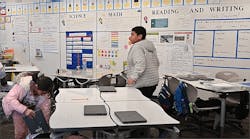When order and regimentation were overriding elements of a classroom climate, a teacher typically was found at the front of a rectangular room, delivering facts and wisdom to an audience of students organized in precise rows of desks nailed to the floor.
In an environment where the recognized learning styles consisted of "you get it" or "you don't," little thought was given to whether a student was comfortable — school was not supposed to be easy or fun.
No one is advocating a return to this antiquated method of classroom instruction. Still, too many learning spaces are outfitted the way they were generations ago. The furniture in a school setting needs to keep pace with the changes in education. To accommodate the needs of students with different shapes, sizes and learning styles, to incorporate the technology that has become an indispensable ingredient in modern education, and to embrace new ways of teaching, education institutions need to have their learning spaces equipped with furnishings that keep students comfortable and healthy while providing the flexibility to adjust to changing educational conditions.
Adapting to differences
Having a teacher stand at the front of a classroom and transmit information to students may be an effective way for some students to absorb knowledge, but educators have realized that other students respond better to different approaches. Some respond better to hands-on experiences, or more relaxed, informal settings, or small-group interactions with their fellow students; some learn more effectively on their own curled up on a pillow reading, or tapping away at a computer keyboard.
If a classroom offers only traditional desks and chairs for students, it can be more difficult to accommodate learning styles that don't fit the teacher-centered approach. As more students become accustomed to new and different ways of receiving information — text messaging, social networking, online videos, podcastings — and as schools adopt approaches such as block schedules of 90-minute class periods, the students may become restless if they are confined to an uncomfortable desk and chair for long stretches.
Chairs that can be adjusted for the different heights and weights of students enable them to find a position of comfort so they can concentrate on work with minimal distractions.
Schools should seek out classroom furnishings that enable a teacher to be more spontaneous — change the surroundings and create a different climate. Lightweight desks or tables that can be moved easily let students divide quickly into small groups. Some teachers outfit their classrooms with sofas, beanbag chairs or other cozy furniture to provide students an area for lounging or quiet reading.
"Conventional chairs have a rigid seat that inclines backward and merges into a seating hollow causing lack of blood circulation, a rounding of the back (and) tense shoulder, neck and back muscles," says a guide to ergonomics from the University of Manitoba in Winnipeg.
It urges schools to provide flexible chairs that enable student to change the seat inclination, or swivel chairs with adjustable heights so that students can rock and spin.
The guide also recommends that schools provide work surfaces with an inclined top of about 16 degrees. "Horizontal tops cause the child's back to become round and their head to bend back as they are working," the guide says.
Allowing students to move around to different furnishings also will help students get some exercise during the school day instead of sitting for lengthy periods.
Taming technology
When desktop computers became commonplace in classrooms, administrators at schools and universities responsible for furniture had to address concerns about whether workstations were sized correctly and adjusted properly so that students could use computers comfortably.
For many schools, the portability and growing appeal of wireless computing has made laptop computers, and their even tinier cousins, netbooks, the preferred machine. Many college campuses now require incoming students to have a laptop.
The proliferation of laptops raises new challenges for schools and universities trying to provide furniture that enables students to position themselves comfortably and sit with a posture that doesn't put undue strain on their bodies.
"The laptop's compact design …forces laptop users into awkward postures," says a guide for laptop users from the University of California at Berkeley's Ergonomics Program. "When the screen is at the right height, the keyboard position is too high; and when the keyboard is at the right height, the screen is too low."
Ergonomically, the best place for a laptop is on the user's lap.
"Place the laptop on your lap to help keep your wrists straight while keying," the guide says. "An empty 2- or 3-inch binder with the wider end toward your knees will create an angle that will help keep your wrists straight and maximize the height of the screen."
Kennedy, staff writer, can be reached at [email protected].
Web Exclusive
- Read more in the "Stand-up students" sidebar to learn about the Stillwater (Minn.) district's standing desks.



